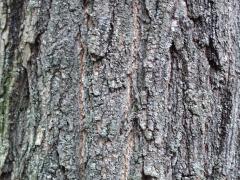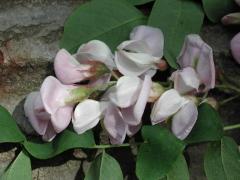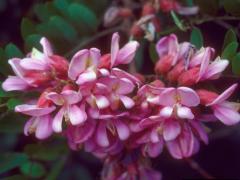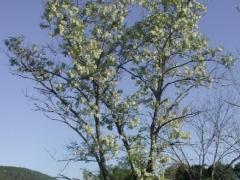Invasive Species: Robinia pseudoacacia, Black Locust
Black locust is a deciduous tree that, while native to parts of the United States, has spread to and become invasive in other parts of the country. Trees grow from 40 to 100 ft. (12 to 30 m) in height. They grow upright in forests but develop an open growth form in more open areas. Leaves are pinnately compound with seven to 21 small, round leaflets per leaf. Leaflets are 1.5 in. (4 cm) long. A pair of long, stipular spines is found at the base of most leaves. Flowering occurs in the spring, when flowers develop in 8 in. (20.3 cm) long clusters. The showy, fragrant, white to yellow flowers give way to a smooth, thin seed pod that is 2 to 4 in. (5.1 to 10.2 cm) in length. The bark of black locust is light brown, rough, and becomes very furrowed with age. Black locust is native to the southern Appalachians, the Ozarks, and other portions of the Midsouth but is considered an invasive species in the prairie and savanna regions of the Midwest, where it can dominate and shade those open habitats.
What are invasive species and why should we be concerned about them?
Taxonomy: Scientific and Common Names for This Species
Fabales > Fabaceae > Robinia pseudoacacia L.
Synonym(s): false acacia, yellow locust
Robinia pseudoacacia – USDA PLANTS Profile
Distribution Maps
Black locust – The reported distribution of this invasive species across the United States (Source: Invasive Plant Atlas of the United States)
Up-to-the-minute distribution maps and why they are important
Reporting This Invasive Species
What is the best way and place to report the occurrence of an invasive species?
How to report an invasive species sighting to EDDMapS – Early Detection & Distribution Mapping System
EDDMapS – Report an invasive species to EDDMapS.
Cooperative Extension Offices – Find your local Cooperative Extension office on this map provided by USDA.
How to Identify
This invasive species can be identified by looking for the characteristics described in the paragraphs that follow.
Tree
A deciduous tree that grows from 40 to 100 ft. (12 to 30 m) in height. The bark of black locust is light brown, rough, and becomes very furrowed with age.
|
|
 |
| Leslie J. Mehrhoff, University of Connecticut, bugwood.org | Paul Wray, Iowa State University, bugwood.org |
Foliage
Leaves are pinnately compound with seven to 21 small, round leaflets per leaf. Leaflets are 1.5 in. (4 cm) long. A pair of long, stipular spines is found at the base of most leaves.
 |
 |
| Paul Wray, Iowa State University, bugwood.org | Robert Videki, Doronicum Kft., bugwood.org |
Flower
Flowering occurs in the spring, when showy, fragrant, white to yellow flowers develop in 8 in. (20.3 cm) long clusters.
 |
 |
| Leslie J. Mehrhoff, University of Connecticut, bugwood.org | Leslie J. Mehrhoff, University of Connecticut, bugwood.org |
Fruit
Fruit is a smooth, thin seed pod that is 2 to 4 in. (5.1 to 10.2 cm) in length.
 |
 |
| Ken Chamberlain, The Ohio State University, bugwood.org | Keith Kanoti, Maine Forest Service, bugwood.org |
Native Species That Can Resemble Black Locust
Robinia hispida, bristly locust, Bugwood.org
 |
 |
| Richard Webb, Self-employed horticulurist, Bugwood.org | Robert Videki, Doronicum Kft., Bugwood.org |
Robinia neomexicana, New Mexico locust, Bugwood.org
 |
 |
| Dave Powell, USDA Forest Service, Bugwood.org | William M. Ciesla, Forest Health Management International, Bugwood.org |
Additional Images for Black Locust
Black locust – Images at Invasive.org
Learning Resources for Black Locust
Robinia pseudoacacia Identification Card – US Fish & Wildlife Service
Robinia pseudoacacia Fact Sheet – US Fish & Wildlife Service
Additional Information, Biology, Control and Management Resources
Control and management recommendations vary according to individual circumstances. Location, habitat, weather, and a variety of other conditions are factors that help determine the best treatment choice. To find the safest and most effective treatment for your situation, consult your state’s land-grant institution. If you will use chemicals as part of the control process, always refer to the product label.
United States Land-Grant University System – Find your land-grant university’s college of agriculture, Cooperative Extension office, or other related partner on this map provided by USDA
Fire Effects Information System – US Forest Service
Silvics of North America – US Forest Service
Element Stewardship Abstract – The Nature Conservancy
Weeds Gone Wild: Alien Plant Invaders of Natural Areas – Plant Conservation Alliance
Invasive Plant Atlas of New England – University of Connecticut

